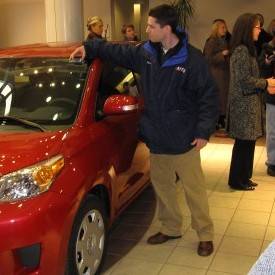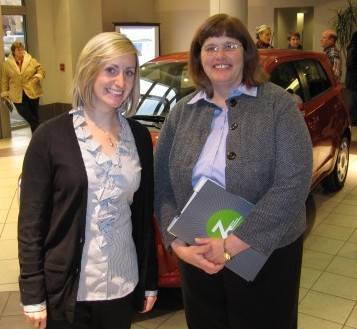 Could you live without a second car, or perhaps any car at all? For many of us, it’s hard to envision life without an automobile of our very own; but then again, there hasn’t always been a plausible alternative. Sharing a car in Champaign-Urbana is now an option with the introduction of Zipcar. The Cambridge, Massachusetts-based company will provide six cars for membership-based, short-term rental at three different locations in C-U: two at the Illinois Terminal in the parking lot at Neil and Washington in Champaign, two on Wright Street in front of Kappa Alpha Theta and Chi Omega, and two at Lincoln Square in Urbana.
Could you live without a second car, or perhaps any car at all? For many of us, it’s hard to envision life without an automobile of our very own; but then again, there hasn’t always been a plausible alternative. Sharing a car in Champaign-Urbana is now an option with the introduction of Zipcar. The Cambridge, Massachusetts-based company will provide six cars for membership-based, short-term rental at three different locations in C-U: two at the Illinois Terminal in the parking lot at Neil and Washington in Champaign, two on Wright Street in front of Kappa Alpha Theta and Chi Omega, and two at Lincoln Square in Urbana.
Zipcar allows members to reserve cars online for a minimum of one hour, or a maximum of four days. For non-students (find out more here), membership incurs a $25 signup fee, a $50 annual fee (which as an initial incentive can be applied toward usage charges) and from there, you pay as you go. The rates are $9 $8 per hour or $66 per day, which includes gas and insurance. The startup costs for students are lower (find out more here), but the usage rates are the same.

Zipcar is already well-established in larger metropolitan areas, including Chicago, and C-U will be one of the smallest communities that the company has established a presence in. “It’s kind of new for them to be in a place this small,” said Morgan Johnston, Transportation Demand Management Coordinator for the University of Illinois. “[C-U is] not that small, but compared to Chicago it is.”
The Zipcar program was unveiled yesterday at a press conference at Illinois Terminal, attended by representatives from the City of Champaign, City of Urbana, University of Illinois and C-U Mass Transit District, who collaborated to bring the program to C-U.
Jay Rank, CUMTD Transportation Analyst, demonstrated how to unlock a Scion xD parked inside the terminal (the other five vehicles were lined up outside) using a Zipcard, the credit card-styled badge that members are issued. A radio frequency identification chip on the dash confirms the registration (made online or with your cell phone) and unlocks the doors, and the key is attached to the steering column. A credit card is stored above the visor to pay for gas, and you’re expected to fill up if your trip will leave the car with less than a quarter-tank.
There are a variety of cars to choose from: in addition to the Scion, there are three Mazda 3s, one Toyota Prius and one Toyota Matrix.
The four sponsoring organizations share some financial risk, as they are guaranteeing Zipcar a baseline revenue at the beginning of the program. In order for the vehicles to be financially viable, they need to generate $1,500 per vehicle per month, or else Champaign, Urbana, U of I and CUMTD make up the difference. “Most of our universities have [baseline revenue guarantees],” said Blair Slocum, Marketing and Account Manager for Zipcar. “It’s just an initial [incentive], making it worth it to come out here [and allow the program to get established].” Once the program meets baseline revenues for two consecutive quarters, Zipcar is on its own.
“They tell you that you need 50 people who will use them for standard, day-to-day things to support a car,” Johnston said. “My expectation was that of course we would get 300 people (for the six cars). Community members, I think, are pretty excited about it.”
 According to Slocum, there may be a significant financial advantage to joining Zipcar. “Normal car owners save $600 a month with Zipcar,” she claimed. That may be more likely in larger cities where parking and insurance are larger proportions of the cost of car ownership, but for occasional drivers, the possibility for savings exists.
According to Slocum, there may be a significant financial advantage to joining Zipcar. “Normal car owners save $600 a month with Zipcar,” she claimed. That may be more likely in larger cities where parking and insurance are larger proportions of the cost of car ownership, but for occasional drivers, the possibility for savings exists.
Johnston explained that six cars may not be the limit to Zipcar’s local fleet. “As soon as they’re booked solid, Zipcar’s adding more,” she noted. “Once it’s covering their expenses, they’ll add them.”
Jan Kijowski, CUMTD Marketing Coordinator, said that the cars would be available almost immediately. “Our plan after this press conference is to take them to their homes on campus and Lincoln Square and make them available right away,” she said. “Once we get everything straightened out and make sure they’re fueled and all that good stuff, they’ll be available.”








